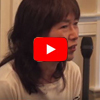The Miracle You Can Have Every Day, Part 6: Exercise, Aging and the Brain
Blog / Produced by The High Calling
"I like your king," she said, looking at my ring.
"Oh, I mean, what do you call that?" My grandmother touched the gem at the tip of my ring.
"Ring, Grammy."
"I make so many mistakes these days," she said. "Losing my mind a little."
And she was. Over the next three years, she forgot what a ring was called, not even reaching for rhyming words in replacement. She tried walking home on a major highway after pulling her car over and leaving it on the shoulder, an hour away from her house. She told my mother, "I know you. You're my friend, aren't you?" while relating how she used to have some children but she didn't know where they were now. When she finally started wearing pocketbooks for shoes and forgetting how to care for herself in the bathroom and attacking my mother at night (thinking a stranger was in the house), the hard decision was made: Grammy would need full-time supervision at a nursing care facility.
I watched my mother watch her mother fall apart. I cried when Grammy's mind finally forgot to eat and drink, and the nursing home counseled my mother to let them ease Gram out of this life with morphine.
We all face the prospect of aging, and the pain it can bring, but how we age is more in our control than we generally think.
Ellen J. Langer, author of Mindfulness, notes that our culture has a cognitive pre-commitment to the idea that getting older means mental degeneration, physical degradation, and a lack of personal growth. We talk about being "over the hill" at a mere 30 years of age, when it is possible to live to 104 and still be vital. John Medina, author of Brain Rules, speaks similarly to Langer, asserting that while getting older is a given, how we get older is not. Says Medina, "Your lifetime risk for general dementia is literally cut in half if you participate in leisure-time physical activity." Alzheimers is even more affected, he notes. Aerobic exercise lowers your odds of getting the disease, by more than 60 percent.
Can we really afford to sit on the couch? In our cubicles? At our desks in school?
John Ratey says no. Absolutely not. Because if we aren't "busy living, [our] bodies will be busy dying." If, for instance, synaptic activity decreases and dendrites retract because we aren't using our minds, then the capillaries in our brains shrink back and restrict blood flow. Or, if capillaries shrink back because we don't get our blood pumping enough, then the dendrites retract. Either way it's deadly—killing neurons or preventing the birth of new ones—and our chances for dementia, Alzheimers and Parkinson's go up.
Because the cardiovascular and metabolic systems are intricately linked to the brain, this means that when we kill the body through inactivity or abuse, we kill the brain. Conversely, when we run to lower our blood pressure or lift weights to fight osteoporosis, we are actually running and lifting for the neurons in our brains. For best results, Ratey recommends a smorgasbord of aerobics, strength training, and exercise for balance and flexibility. Mix it up, and do it at least four times a week.
My strongest memories of my Grammy are of her sitting and playing Bridge, at least four times a week. It was, in its way, good for her mind. I only wish she'd known how important it was to walk across more bridges too, or run for the very life of her brain.
_____
Read Part One? The Miracle You Can Have Every Day: Exercise, Learning, and the Brain
Read Part Two? The Miracle You Can Have Every Day: Exercise, Anxiety, and the Brain
Read Part Three? The Miracle You Can Have Every Day: Exercise, Depression, and the Brain
Read Part Four? The Miracle You Can Have Every Day: Exercise, ADHD, and the Brain
Read Part Five? The Miracle You Can Have Every Day: Exercise, Addiction, and the Brain
Image by Aidan McCarthy. Used with permission via Flickr. Information about aging and exercise is from John Ratey's book Spark. Post by L.L. Barkat, author of God in the Yard: Spiritual Practice for the Rest of Us.
“Most of the material on The High Calling is available for reuse under a Creative Commons 3.0 license. Unfortunately, work by Laura Barkat is not available for reuse. If you are interested in reprinting work by Laura Barkat, please contact her directly.”





